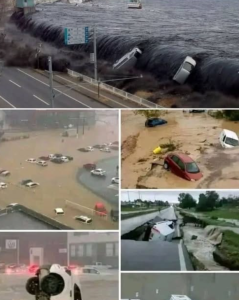
March 11, 2011 — Sendai, Japan:
It began at 2:46 p.m. local time—a deep rumble beneath the Pacific Ocean floor, approximately 70 kilometers (43 miles) east of the Oshika Peninsula of Tōhoku. Within seconds, the ground began to shake violently, and within minutes, one of the most catastrophic natural disasters in human history was underway. A massive 9.1 magnitude earthquake, the most powerful ever recorded in Japan, had struck. But the horror was just beginning.
The Earthquake Strikes
Sendai, a bustling coastal city of over one million people and the capital of Miyagi Prefecture, was one of the closest major urban centers to the epicenter. As the quake hit, buildings swayed and cracked. Roads buckled. Entire neighborhoods lost power instantly. Cell networks collapsed. Inside schools, offices, and homes, people scrambled for cover—clutching doorframes, hiding under desks, and praying the tremors would end.
But they didn’t—not quickly. The quake lasted over six terrifying minutes. It wasn’t just a jolt. It was a rolling, deafening upheaval that seemed endless.
Many structures built to earthquake standards survived the initial shake, but the aftermath would test even the strongest designs.
A Wall of Water
Just 30 minutes after the quake, residents of Sendai’s coastal districts heard a distant roar—like a thousand freight trains approaching from the sea. It was a tsunami, triggered by the violent displacement of the ocean floor.
With terrifying speed, waves—some as high as 40 meters (131 feet) in certain areas—slammed into the coastline. The seawall was no match. Entire fishing villages were swept away in seconds. In Sendai’s port area, the water surged inland up to 10 kilometers (6 miles), swallowing farmland, highways, airports, and homes.
Footage later revealed the monstrous black wave ripping across fields, lifting cars like toys, and demolishing everything in its path. People ran for their lives, but many were caught. The water was cold, filled with debris, and deadly.
The Sendai Airport was among the first major landmarks to be overrun. Planes were tossed, and the runway was submerged. All operations ceased instantly.
Unthinkable Loss
In the hours and days following, the full scale of the disaster came into focus. Over 18,000 people were killed or declared missing, with thousands more injured. The majority of the deaths were caused not by the quake, but by the tsunami.
Entire families were lost. Elderly residents in coastal retirement homes, children at school, parents at work—so many simply disappeared beneath the waves.
Massive fires broke out, fueled by ruptured gas lines and flammable debris. Rescue efforts were complicated by flooded roads, broken communication systems, and the constant threat of aftershocks.
But perhaps the most haunting development came from a place 240 kilometers south of Sendai: the Fukushima Daiichi Nuclear Power Plant.
The Nuclear Crisis
The earthquake and tsunami knocked out the plant’s power and backup generators. Without cooling, the reactors began to overheat. Over the next few days, three nuclear reactors melted down, causing hydrogen explosions and releasing radioactive material into the air and sea.
Tens of thousands were evacuated from a 20-kilometer radius. The world watched in fear as Japan teetered on the edge of a nuclear catastrophe. Farmers abandoned their land. Residents fled their homes—many never to return.
It became the worst nuclear disaster since Chernobyl in 1986, and it would take over a decade of effort, billions of dollars, and an untold emotional toll to even begin containing the damage.
Acts of Heroism and Resilience
Amid the horror, stories of courage and sacrifice emerged.
A schoolteacher in Miyagi Prefecture refused to leave until every student was accounted for—only to be swept away in the final wave. A helicopter crew hovered dangerously close to collapsing buildings to lift stranded survivors. In Sendai, shop owners gave away food and supplies freely to those who had nothing left.
Volunteers from across Japan and the world flooded in to help. The Japanese Self-Defense Forces launched one of the largest rescue operations in the nation’s history. Teams from the U.S., China, South Korea, Australia, and dozens more offered aid and manpower.
The nation united in grief—and resolve.
Rebuilding a City and Spirit
Sendai, though battered and scarred, did not crumble. Over the months that followed, citizens rebuilt brick by brick, road by road. Temporary housing sprouted. Schools resumed. Businesses reopened, even amid sorrow.
But the psychological scars remained. Children who survived grew up with nightmares and anxiety. Many elderly residents never fully recovered from the loss of their homes and loved ones.
The government invested billions in infrastructure—new sea walls, higher evacuation platforms, smarter alert systems. The phrase “Build Back Better” became a rallying cry.
The Legacy of 3/11
March 11, now simply referred to in Japan as “3/11,” remains a national day of remembrance.
Annually, bells toll, moments of silence are observed, and lanterns are floated down rivers in honor of the souls lost to sea. Survivors share their stories with the younger generation, hoping the lessons of preparedness and resilience will never be forgotten.
The Tōhoku Earthquake and Tsunami reshaped not just the land—but the identity of a nation.
And in Sendai, where waves once erased the lives of thousands in minutes, cherry blossoms bloom again every spring—a symbol of rebirth, hope, and enduring strength.
